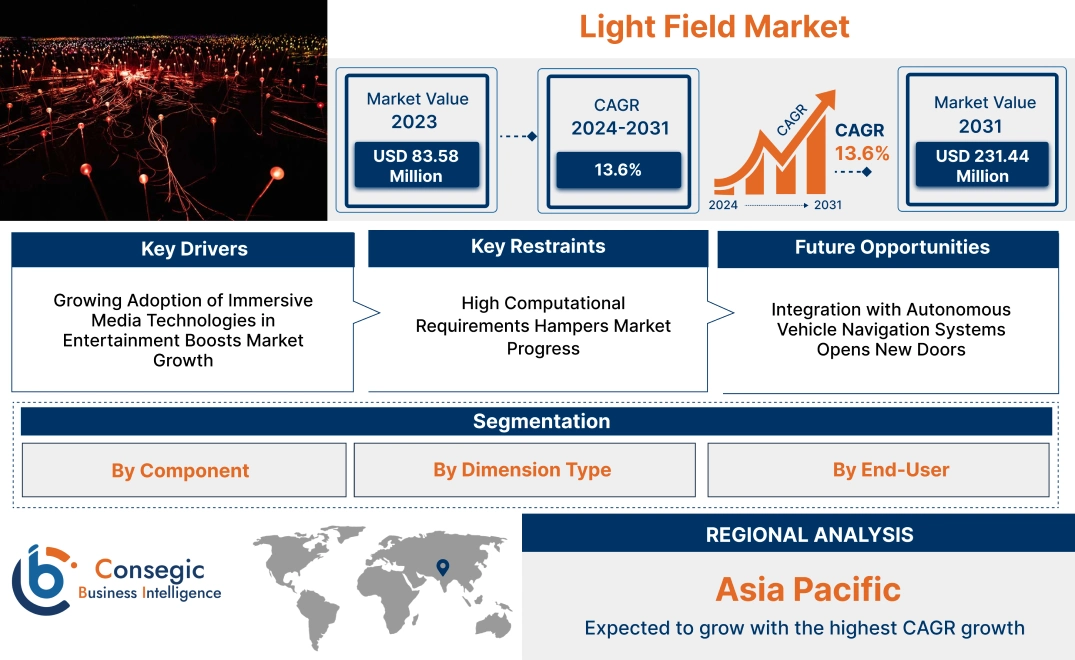- Summary
- Table Of Content
- Methodology
Light Field Market Size:
Light Field Market size is estimated to reach over USD 231.44 Million by 2031 from a value of USD 83.58 Million in 2023 and is projected to grow by USD 93.44 Million in 2024, growing at a CAGR of 13.6% from 2024 to 2031.
Light Field Market Scope & Overview:
The light field refers to a visual technology that captures the intensity and direction of light rays within a scene, enabling the creation of highly immersive and realistic images or videos. This technology relies on advanced imaging systems and computational algorithms to provide a multidimensional view, offering depth, focus adjustment, and perspective changes. Light field technology is utilized in applications such as virtual reality (VR), augmented reality (AR), photography, and holography, delivering enhanced visual experiences.
Light field systems are designed to capture intricate details and enable post-processing capabilities, such as refocusing and 3D rendering, making them suitable for creative, entertainment, and scientific applications. The technology is supported by specialized cameras, sensors, and software, ensuring precise data capture and processing for various use cases.
End-users of this technology include industries such as media and entertainment, healthcare, automotive, and aerospace, where immersive imaging and advanced visualization are critical. These systems are increasingly integrated into workflows to enhance visualization, improve accuracy, and deliver innovative user experiences across different sectors.
Light Field Market Dynamics - (DRO) :
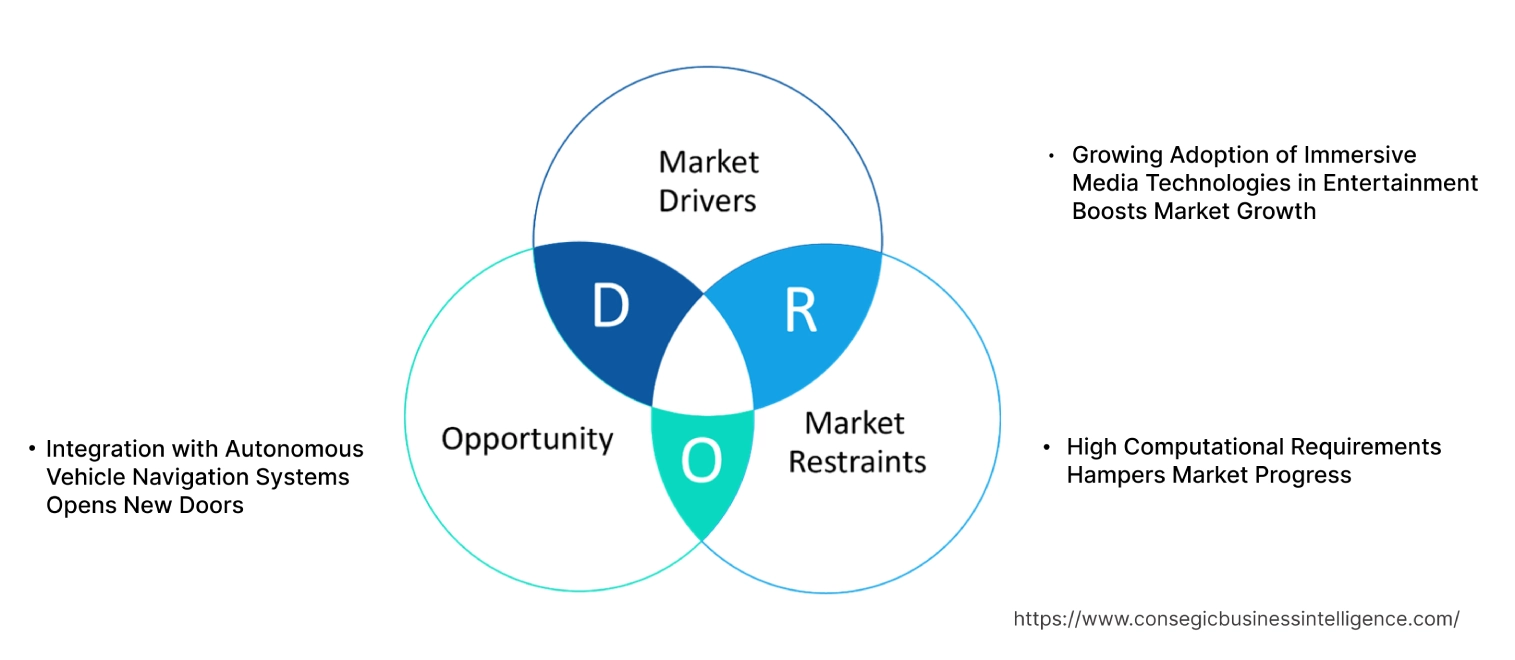
Key Drivers:
Growing Adoption of Immersive Media Technologies in Entertainment Boosts Market Growth
The increasing demand for immersive media technologies in the entertainment industry is driving advancements in light field technology. This technology enables the creation of highly realistic 3D visual experiences, making it ideal for applications in virtual reality (VR), augmented reality (AR), and high-end cinematography. Production studios and gaming companies are leveraging this technology to deliver enhanced user experiences through lifelike visuals and interactive content. As per the market trends, the integration of this technology in AR/VR smart glasses, headsets, and 3D displays is reshaping the entertainment sector, catering to the rising consumer demand for cutting-edge visual experiences, and driving light field market growth.
Key Restraints :
High Computational Requirements Hampers Market Progress
The high computational demands of light field technology present a significant barrier to its widespread adoption. Capturing and processing light field data requires advanced hardware, including high-resolution cameras, specialized sensors, and powerful computing systems. These systems must handle vast amounts of data to accurately render 3D visuals with depth and spatial information, leading to increased infrastructure and operational costs. Additionally, the processing power required for real-time applications, such as augmented reality (AR) or virtual reality (VR), further compounds the challenge, as many existing systems cannot meet these requirements without significant upgrades.
Industries adopting light field solutions must also invest in technical expertise and custom software, adding to implementation complexity. These high computational requirements limit scalability and accessibility, particularly for small and medium-sized enterprises and consumer-grade applications. As a result, the adoption of this technology remains confined to industries with substantial resources, such as high-end entertainment, medical imaging, and automotive research, creating a significant restraint for light field market demand.
Future Opportunities :
Integration with Autonomous Vehicle Navigation Systems Opens New Doors
The integration of light field technologies into autonomous vehicle navigation systems offers a transformative opportunity for enhancing vehicle safety and performance. Light field imaging provides unparalleled depth sensing and spatial mapping capabilities, allowing vehicles to capture highly detailed, real-time 3D data of their surroundings. This enables accurate detection of objects, obstacles, and road conditions, even in complex environments such as urban traffic or poor weather.
By offering precise spatial awareness, light field systems enhance decision-making processes for autonomous vehicles, improving navigation, collision avoidance, and route optimization. Unlike traditional sensors, this technology delivers richer depth information, making it particularly valuable for Level 4 and Level 5 autonomous vehicles. As the automotive sector continues to prioritize advanced sensing and navigation solutions, the adoption of light field imaging is expected to grow. Its ability to seamlessly integrate with LiDAR, radar, and other sensor technologies positions it as a critical component in the evolution of fully autonomous driving systems, creating light field market opportunities.
Light Field Market Segmental Analysis :
By Component:
Based on components, the market is segmented into hardware (light field displays, cameras, lenses, sensors) and software (rendering software, simulation software, image processing software).
The hardware segment accounted for the largest revenue of 68.35% of the total light field market share in 2023.
- Light field displays are critical for creating immersive visual experiences, enabling precise depth perception and realistic 3D visualizations.
- Cameras and sensors capture multi-angle light data essential for creating accurate and detailed light field imagery, with applications in healthcare imaging, automotive design, and simulation.
- Technological advancements in lenses, including microlens arrays, are enhancing the resolution and field of view in light field systems.
- The dominance of hardware reflects its foundational role in enabling the capture, processing, and display of light field data for diverse applications, driving light field market expansion.
The software segment is expected to register the fastest CAGR during the forecast period.
- Rendering software enables the creation of highly realistic light field visuals, making it indispensable for applications in film production and architectural visualization.
- Simulation software plays a vital role in testing and prototyping products in industries such as automotive and defense, reducing development time and costs.
- Image processing software ensures precise manipulation of light field data, enabling high-quality visual outputs tailored to specific use cases.
- As per light field market analysis, the rapid expansion of this segment is supported by advancements in artificial intelligence and machine learning for enhanced rendering and simulation capabilities.
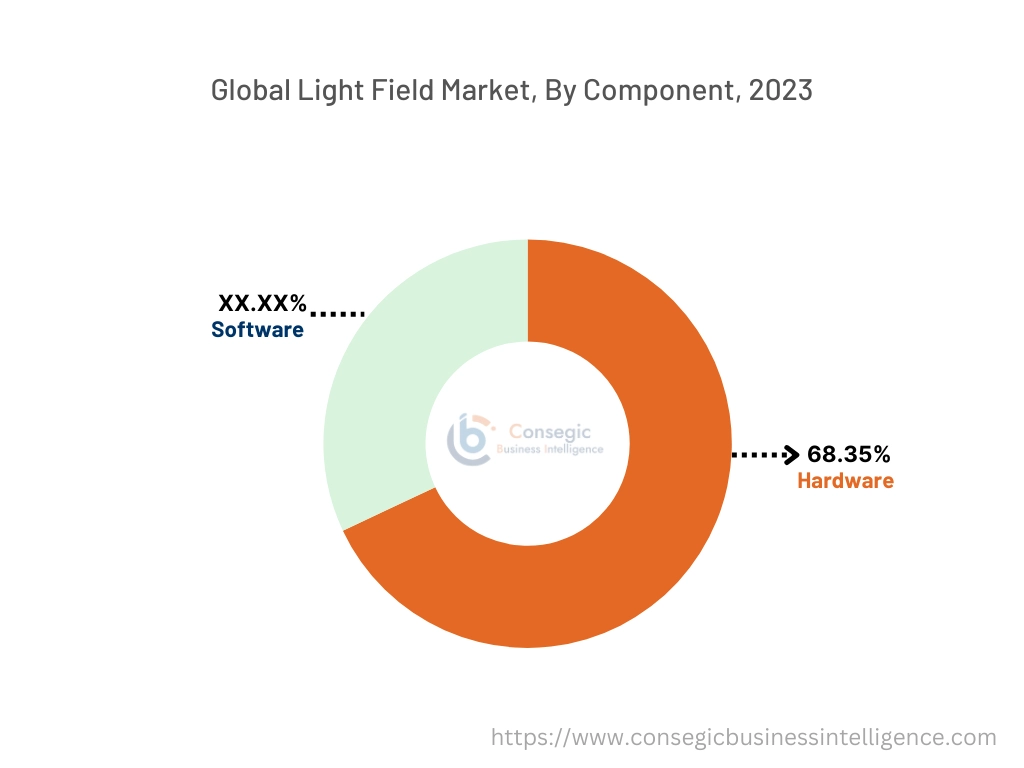
By Dimension Type:
Based on dimension type, the market is segmented into 2D Light Field and 3D Light Field.
The 3D Light Field segment held the largest revenue of the total light field market share in 2023.
- 3D light field technology offers highly immersive visual experiences, making it a preferred choice for applications such as virtual reality (VR), gaming, and medical imaging.
- The ability to render realistic depth perception and multi-angle views enhances its adoption in film production and architectural design.
- Automotive manufacturers leverage 3D light field solutions for advanced driver-assistance system (ADAS) testing and virtual prototyping of vehicle designs.
- The dominance of this segment is attributed to its ability to provide unparalleled realism and accuracy, meeting the requirements of high-end applications across industries, driving light field market growth.
The 2D Light Field segment is expected to register the fastest CAGR during the forecast period.
- 2D light field systems are widely used for applications where depth perception is not the primary focus, such as in retail displays and simpler visualization tasks.
- These systems are cost-effective and easier to deploy compared to 3D light field solutions, making them ideal for small-scale industries and emerging markets.
- The increasing integration of 2D light field displays in consumer electronics, including smartphones and tablets, supports the growth of this segment.
- As per light field market trends, the rapid progress of this segment reflects its versatility and widespread adoption across diverse use cases requiring simpler visual outputs.
By End-User:
Based on end-user, the market is segmented into film & animation studios, healthcare providers, automotive manufacturers, architects, retailers, and defense organizations.
The film & animation studios segment accounted for the largest revenue share in 2023.
- Light field technology is revolutionizing the film and animation industry by enabling hyper-realistic visual effects and immersive storytelling experiences.
- Studios use light field displays to visualize and manipulate scenes in real time, improving creative workflows and reducing production timelines.
- The ability to simulate realistic environments and dynamic lighting conditions enhances the quality and visual appeal of animated content.
- As per market trends analysis, the dominance of this segment is supported by the increasing adoption of light field solutions for creating groundbreaking visuals in blockbuster movies and high-end productions, fueling light field market demand.
The healthcare providers segment is expected to register the fastest CAGR during the forecast period.
- Light field systems are being increasingly used in medical imaging for creating detailed 3D models of anatomical structures, enhancing diagnosis and surgical planning.
- Healthcare providers utilize light field displays for training and education, offering highly interactive and immersive learning experiences.
- The ability to integrate with existing imaging modalities, such as CT and MRI, ensures seamless adoption in hospitals and diagnostic centers.
- As per segmental trends analysis, the rapid proliferation of this segment reflects the growing focus on improving patient outcomes through advanced visualization and diagnostic tools, driving light field market expansion.
Regional Analysis:
The regions covered are North America, Europe, Asia Pacific, the Middle East and Africa, and Latin America.
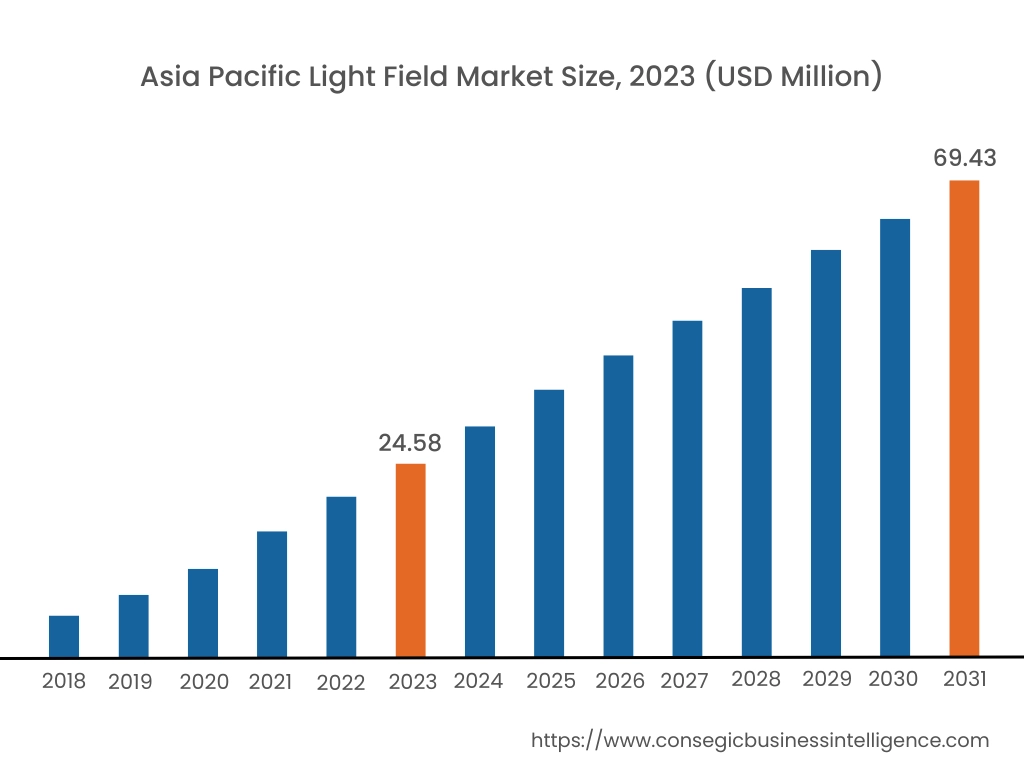
Asia Pacific region was valued at USD 24.58 Million in 2023. Moreover, it is projected to grow by USD 27.53 Million in 2024 and reach over USD 69.43 Million by 2031. Out of these, China accounted for the largest share of 41.5% in 2023. Asia-Pacific is witnessing the fastest growth in the market, driven by rapid industrialization and urbanization in countries like China, Japan, and India. The region has become a global hub for technology production, with a strong emphasis on consumer electronics and entertainment. Thus, as per market trends analysis, the increasing investments in 3D displays and sensors are further propelling light field market opportunities.
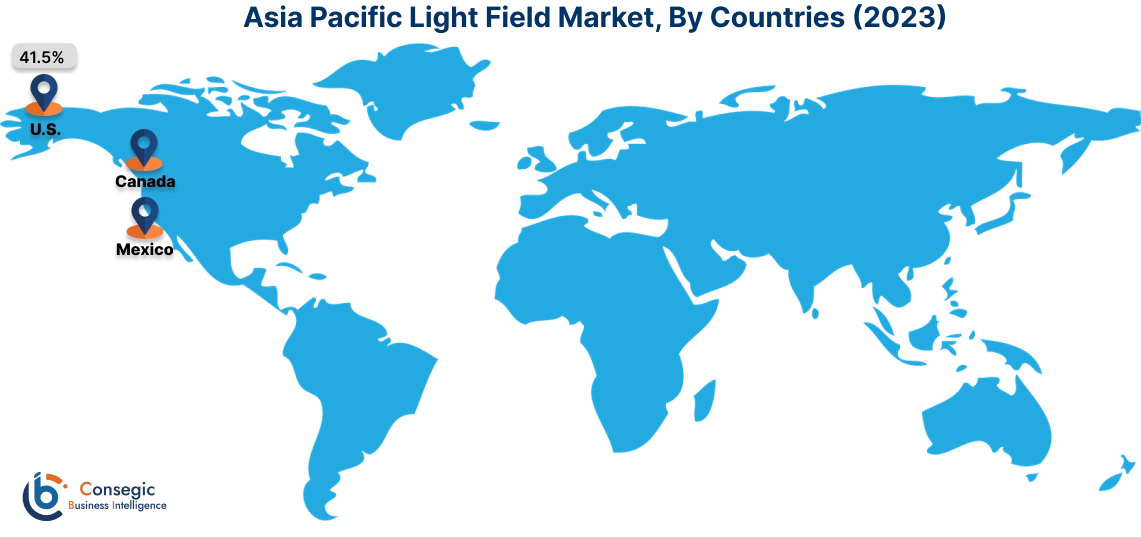
North America is estimated to reach over USD 76.15 Million by 2031 from a value of USD 27.78 Million in 2023 and is projected to grow by USD 31.03 Million in 2024. The market in North America is experiencing significant growth, primarily driven by substantial investments in light field and 3D imaging technologies. Organizations in the region are extensively investing in these technologies to fuel market progress. The United States leads in research and development investments for light field technology, driving innovation and market development. The region's receptiveness to adopting light field and 3D imaging technologies has been instrumental in enhancing visualization and providing augmented customer experiences. This trend is further supported by the expansive use of these technologies across various industries, including media and entertainment, healthcare, and industrial sectors.
Europe represents a significant portion of the global light field market, with countries like Germany, France, and the United Kingdom leading in terms of adoption and innovation. The region benefits from a well-established technology sector and a strong emphasis on immersive media experiences. As per the market trends analysis, the demand for advanced imaging solutions is increasing, driven by applications in media, entertainment, and healthcare.
The Middle East & Africa region shows promising potential in the light field market, particularly in countries like Saudi Arabia, the United Arab Emirates, and South Africa. Increasing investments in technology infrastructure and the extension of the media and entertainment industry are driving the demand for advanced imaging solutions. As per light field market trends, the focus on diversifying economies and reducing dependence on oil revenues has led to growth in the technology sector.
Latin America is an emerging market for light field technology, with Brazil and Mexico being the primary growth drivers. The rising adoption of advanced imaging solutions, improving technology infrastructure, and increasing focus on enhancing media experiences contribute to the market’s enlargement. As per light field market analysis, government initiatives aimed at modernizing technology networks and promoting innovation are supporting market progress.
Top Key Players & Market Share Insights:
The light field market is highly competitive with major players providing products and services to the national and international markets. Key players are adopting several strategies in research and development (R&D), product innovation, and end-user launches to hold a strong position in the global light field market. Key players in the light field industry include –
- Light Field Lab (USA)
- CREAL (Switzerland)
- Raxium (USA)
- Brelyon (USA)
- MOPIC (South Korea)
- Sony Corporation (Japan)
- Lytro (USA)
- Lumus (Israel)
- Meta Platforms, Inc. (USA)
- Google LLC (USA)
Recent Industry Developments :
Product Launch:
- In August 2024, Samsung unveiled the Odyssey 3D gaming monitor, which uses light field technology to deliver a glasses-free 3D experience. This innovative display projects light in multiple directions, allowing users to perceive depth and 3D visuals naturally, without the need for special glasses. The monitor eliminates common issues like eye strain and nausea, providing a comfortable and immersive gaming experience. This breakthrough in light field technology promises to revolutionize 3D gaming by offering true-to-life visuals and a more accessible, natural viewing experience.
Light Field Market Report Insights :
| Report Attributes | Report Details |
| Study Timeline | 2018-2031 |
| Market Size in 2031 | USD 231.44 Million |
| CAGR (2024-2031) | 13.6% |
| By Component |
|
| By Dimension Type |
|
| By End-User |
|
| By Region |
|
| Key Players |
|
| North America | U.S. Canada Mexico |
| Europe | U.K. Germany France Spain Italy Russia Benelux Rest of Europe |
| APAC | China South Korea Japan India Australia ASEAN Rest of Asia-Pacific |
| Middle East and Africa | GCC Turkey South Africa Rest of MEA |
| LATAM | Brazil Argentina Chile Rest of LATAM |
| Report Coverage |
|
Key Questions Answered in the Report
How big is the Light Field Market? +
Light Field Market size is estimated to reach over USD 231.44 Million by 2031 from a value of USD 83.58 Million in 2023 and is projected to grow by USD 93.44 Million in 2024, growing at a CAGR of 13.6% from 2024 to 2031.
What specific segmentation details are covered in the Light Field Market report? +
The Light Field Market report includes segmentation details for components (Hardware: Light Field Displays, Cameras, Lenses, Sensors; Software: Rendering Software, Simulation Software, Image Processing Software), dimension type (2D Light Field, 3D Light Field), end-user (Film & Animation Studios, Healthcare Providers, Automotive Manufacturers, Architects, Retailers, Defense Organizations), and region (Asia-Pacific, Europe, North America, Latin America, Middle East & Africa).
Which is the fastest-growing segment in the Light Field Market? +
The 2D Light Field segment is expected to register the fastest CAGR during the forecast period due to its increasing use in consumer electronics and simpler visualization applications.
Who are the major players in the Light Field Market? +
The major players in the Light Field Market include Light Field Lab (USA), CREAL (Switzerland), Raxium (USA), Brelyon (USA), MOPIC (South Korea), Sony Corporation (Japan), Lytro (USA), Lumus (Israel), Meta Platforms, Inc. (USA), and Google LLC (USA).
